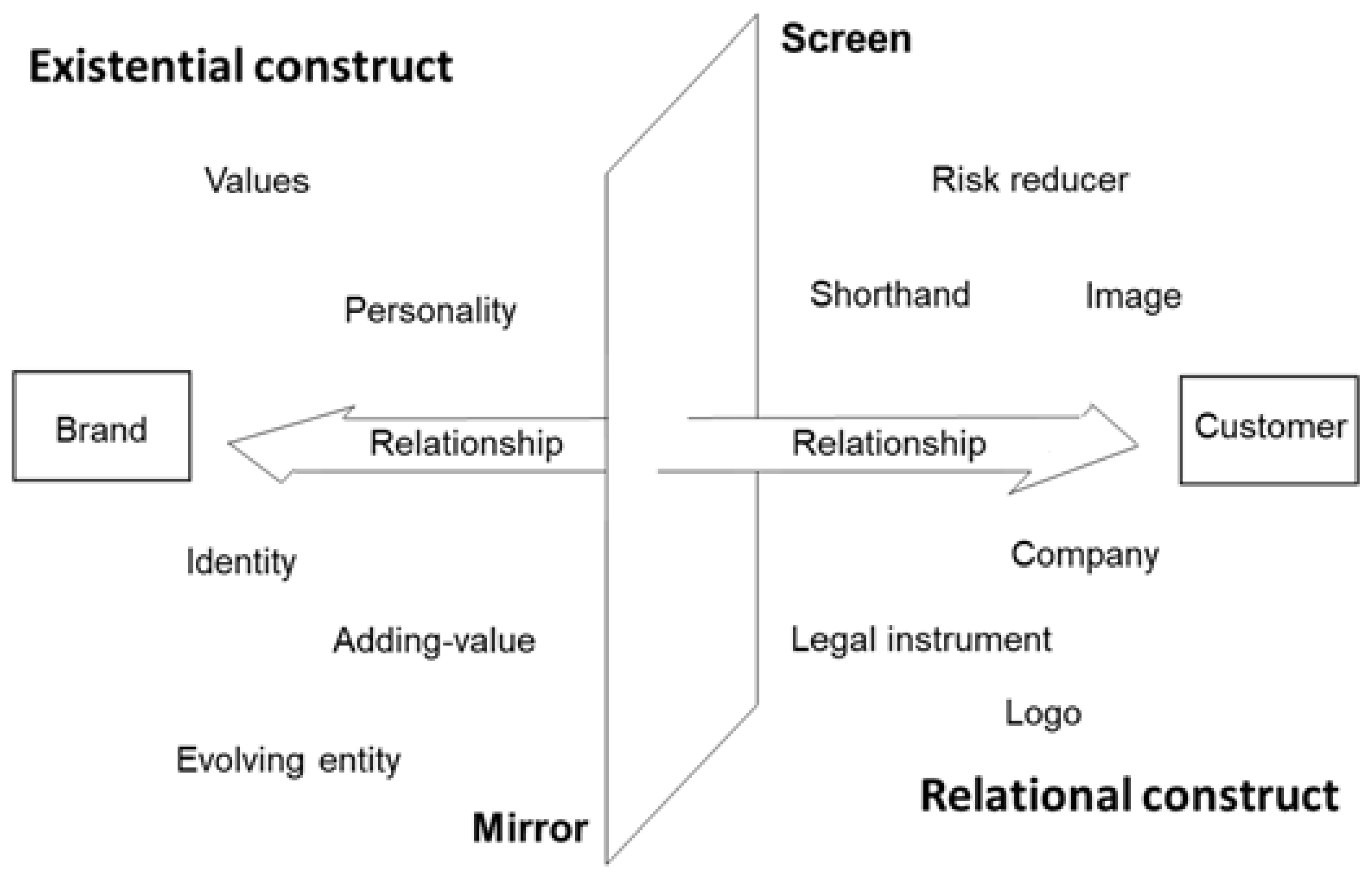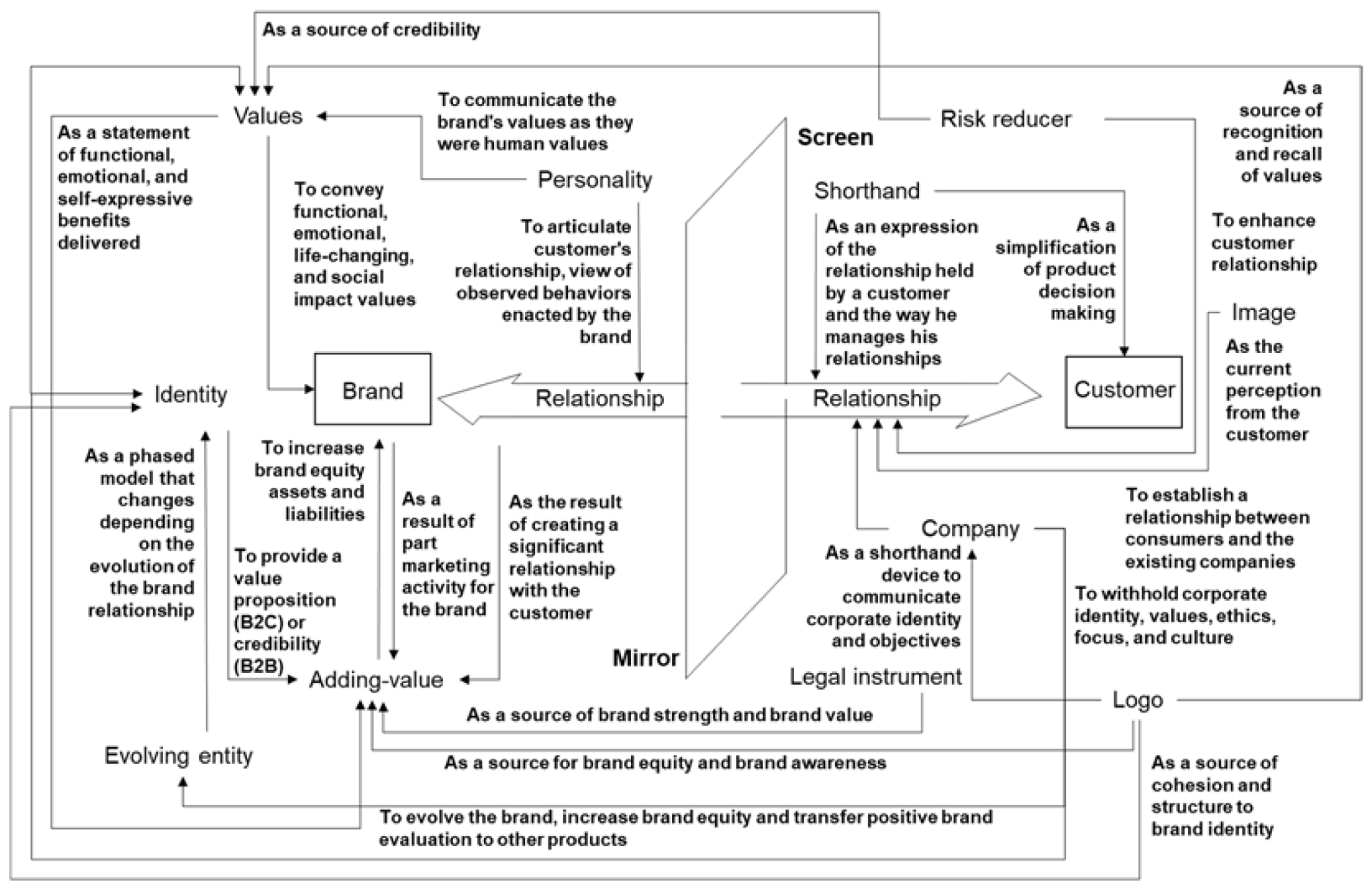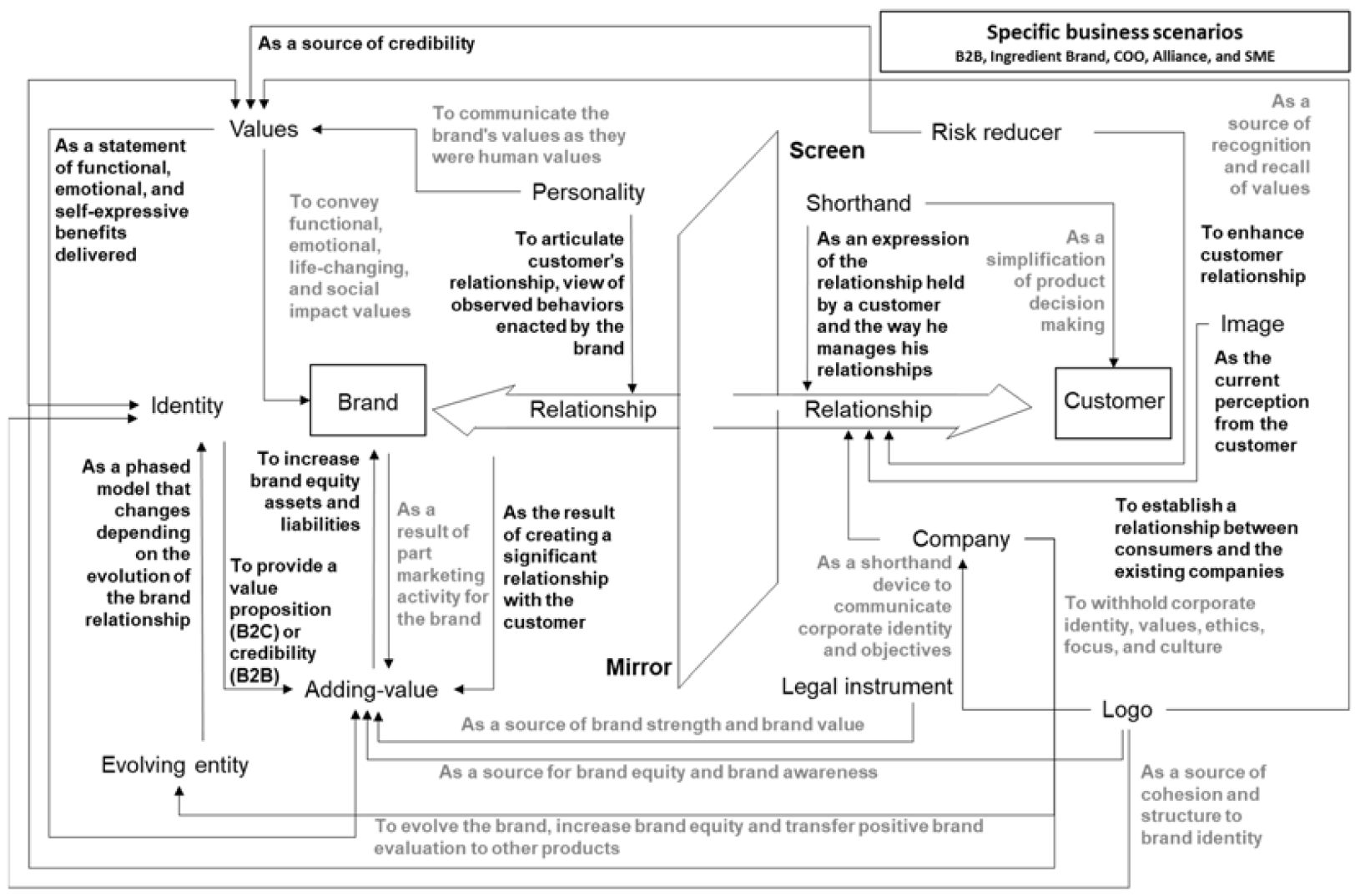A Conceptual Framework for Creating Brand Management Strategies
Abstract
1. Introduction
2. Materials and Methods
3. Results and Discussion
3.1. Dimensional Analysis of Top Brand Management Models
3.1.1. Legal Instrument
3.1.2. Logo
3.1.3. Company
3.1.4. Shorthand
3.1.5. Risk Reducer
3.1.6. Identity System
3.1.7. Image
3.1.8. Value System
3.1.9. Personality
3.1.10. Relationship
3.1.11. Adding Value
3.1.12. Evolving Entity
| Variable\Model | Keller | Aaker | Fournier | Kapferer | De Chernatony |
|---|---|---|---|---|---|
| Legal Instrument | As a legal and competitivity protection | As a source of brand strength | As a source of brand value | As legal protection against counterfeit and competition | |
| Logo | As a source for brand equity and brand awareness; can indicate origin, ownership, or association | As a source of cohesion and structure to brand identity; as a source of recognition and recall of functional, emotional, or self-expressive benefit | As a shorthand device to communicate corporate identity | As a shorthand device to communicate corporate objectives | |
| Company | To extend brand equity to other products into new categories or subcategories | To create and leverage assets | To establish a relationship between consumers and the existing companies | To withhold corporate identity, values, ethics, focus, and culture | To evolve the brand, increase brand equity, and transfer positive brand evaluation to other products |
| Shorthand | As a simplification of product decision making | As a source of recall and recognition of reputation in a specific niche | As an expression of the relationship held by a customer and the way he manages his relationships | As decision-making factor and brand asset for the company | As decision-making factor to overcome the problem of sifting through large amount of information |
| Risk Reducer | As a firm’s expertise and trustworthiness, a source of credibility | As a source of credibility to provide value proposition or enhance customer relationship | To convey certitude when trust is needed | To reduce uncertainty in a purchase or to minimize the chance of an unpleasant outcome | |
| Identity System | As the first stage of the process of brand development | To provide a value proposition (B2C) or credibility (B2B) | To provide uniqueness and value | As an asset, as core values, as a support to the brand promise | |
| Image | To link strong, favorable, and unique associations to the brand in memory | As the current perception from the customer | As the decodation of all the signals emanating from the products, services, and communications | As the customers’ perceptions, in terms of satisfaction with functional and representational needs | |
| Value System | To convey functional, emotional, life-changing, and social impact values | As a statement of functional, emotional, and self-expressive benefits delivered | To express functional, experiential, and aspirational rewards | to express functional, conductional, social, emotional, and epistemic values | |
| Personality | To express sincerity, excitement, competence, sophistication, and ruggedness | To express a set of distinctive and enduring human characteristics associated with a brand | To articulate customer’s relationship, view of observed behaviors enacted by the brand | To create emotional connections between consumers and the brand | To communicate the brand’s values as if they were human values |
| Relationship | To create brand resonance and an intense, active loyalty relationship between customers and the brand | As the bottom line of the brand identity system | To facilitate interactions with the non-material world to provide structure and meanings | To express how a brand acts, delivers services, and relates to its customers | To create a pool of committed, profitable customers |
| Adding Value | As a result of past marketing activity for the brand | To increase brand equity assets and liabilities | as the result of creating a significant relationship with the customer | As the result of trust, pride, emotion, attachment to familiarity capital | As the result of clues that give signals about the offer |
| Evolving Identity | As a cycle: (1) new, (2) niche, (3) leadership, and (4) commodity | to extend further than competitors | As a phased model that changes depending on the evolution of the brand relationship | It evolves according to a product life cycle when attached to a product | As a cycle: (1) development and launching, (2) growth, (3) maturity, and (4) decline |
3.2. Interdimensional Analysis to Understand Relationships between Brand Dimensions
3.3. Proposing a Conceptual Framework for Creating Brand Management Strategies
3.4. Applying the Framework
3.4.1. Selecting Branding Literature According to a Specific Business Scenario
3.4.2. Finding Characteristics of Each Dimension According to a Specific Business Scenario
3.4.3. Proposing a Custom Brand Management Strategy
4. Discussion
5. Conclusions
- Decomposing a brand management model into a set of dimensions it is easier to compare the similitudes and differences between different models.
- Decomposing specific business environments in single-sided business scenarios, allows a better understanding of how the brand management dimensions apply to the specific analyzed case.
- Regardless of the brand management models, all of them converge on the fact that by creating a high-quality brand relationship with the customer is crucial for the branding process.
- The brand personality is at the core of the brand management process, as if it is the entity that articulates the relationship with the customer through company values, benefits, and behaviors.
- Brand identity is important in the creation and reinvention processes of a brand as it expresses the promise of value promoted by the company.
- Brand image is important in the brand management process as it is the customer’s perspective of brand identity or the real link between a customer’s mind and a brand.
- Unavoidable brand functions should be adding value to increase brand equity and perceived value in the customer-brand relationship, reduce risk in transactions, and provide a shorthand or a source of recall and recognition for the customer.
- B2B and ingredient brand management models are well-defined for generic cases, but little is known for COO, SME, or alliance brand cases.
- COO brand management models have not been developed to date. The available literature is based on COO labeling, and labeling literature is mostly based on the agricultural field.
- SME branding literature is firm-centric; thus, it depends on the specific SME size, culture, and business environment among other variables.
- There is little information regarding alliance brand management. The literature explored points to the need of further development of research on the brand management phenomenon for alliance brands.
- This study contributes to theory by identifying nonevident relationships between brand dimensions.
- This study also contributes to theory by proposing a representation of brand dimensions as existential or relational constructs, aiming at the self-expressing and perceived sides of the brand.
Author Contributions
Funding
Acknowledgments
Conflicts of Interest
References
- Keller, K.L.; Lehmann, D.R. Brands and Branding: Research Findings and Future Priorities. Mark. Sci. 2006, 25, 740–759. [Google Scholar] [CrossRef]
- Best Global Brands. 2021. Available online: https://interbrand.com/best-brands/ (accessed on 29 September 2022).
- World Economic Outlook Database, International Monetary Fund; IMF: Washington, DC, USA, 2021.
- Di Somma 18 Different Types Of Brand. Available online: https://www.brandingstrategyinsider.com/2015/01/18-different-types-of-brand.html (accessed on 15 April 2019).
- Lewi, G.; Lacoeuilhe, J.; Albert, A.-S. Branding management: La marque, de l’idée à l’action; Pearson Education France: Paris, France, 2007; ISBN 978-2-7440-7233-8. [Google Scholar]
- Kapferer, J.-N. The New Strategic Brand Management: Creating and Sustaining Brand Equity Long Term; Kogan Page Publishers: London, UK, 2008; ISBN 978-0-7494-5085-4. [Google Scholar]
- Oh, T.T.; Keller, K.L.; Neslin, S.A.; Reibstein, D.J.; Lehmann, D.R. The Past, Present, and Future of Brand Research. Mark. Lett. 2020, 31, 151–162. [Google Scholar] [CrossRef]
- Maurya, U.K.; Mishra, P. What Is a Brand? A Perspective on Brand Meaning. Eur. J. Bus. Manag. 2012, 4, 13. [Google Scholar]
- de Chernatony, L.; Dall’Olmo Riley, F. Defining A “Brand”: Beyond The Literature With Experts’ Interpretations. J. Mark. Manag. 1998, 14, 417–443. [Google Scholar] [CrossRef]
- Robichaud, F.; Richelieu, A.; Kozak, R. Branding as a Communications Strategy: A Framework for Desired Brand Identity. J. Brand Manag. 2012, 19, 712–734. [Google Scholar] [CrossRef]
- de Chernatony, L.; Dall’Olmo Riley, F. Modelling the Components of the Brand. Eur. J. Mark. 1998, 32, 1074–1090. [Google Scholar] [CrossRef]
- Aaker, D.A. Building Strong Brands; Simon and Schuster: New York, NY, USA, 2012; ISBN 978-1-4711-0438-1. [Google Scholar]
- Keller, K.L. Strategic Brand Management, Building Measuring & Managing Brand Equity, 3rd ed.; Pearson Prentice Hall: Hoboken, NJ, USA, 2008. [Google Scholar]
- Swaminathan, V.; Sorescu, A.; Steenkamp, J.-B.E.M.; O’Guinn, T.C.G.; Schmitt, B. Branding in a Hyperconnected World: Refocusing Theories and Rethinking Boundaries. J. Mark. 2020, 84, 24–46. [Google Scholar] [CrossRef]
- Keller, K.L. The Future of Brands and Branding: An Essay on Multiplicity, Heterogeneity, and Integration. J. Consum. Res. 2021, 48, 527–540. [Google Scholar] [CrossRef]
- Balmer, J.M.T. Corporate Branding and Connoisseurship. J. Gen. Manag. 2017. [Google Scholar] [CrossRef]
- Holt, D. Harvard Business Review. 1 March 2016. Available online: http://www.mim.ac.mw/books/Harvard_Business_Review_USA_2016-03.pdf (accessed on 19 November 2022).
- Dall’Olmo Riley, F.; (Faculty of Business and Social Sciences, London, UK). Personal Communication, 2022.
- Patton, M.Q. Enhancing the Quality and Credibility of Qualitative Analysis. Health Serv. Res. 1999, 34, 1189–1208. [Google Scholar]
- De Chernatony, L. Creating Powerful Brands, 4th ed.; Routledge: London, UK, 2010; ISBN 978-1-85617-850-1. [Google Scholar]
- Definitions of Marketing. Am. Mark. Assoc. 2022. Available online: https://www.ama.org/topics/marketing-definition/ (accessed on 19 November 2022).
- Fournier, S. Consumers and Their Brands: Developing Relationship Theory in Consumer Research. J. Consum. Res. 1998, 24, 343–373. [Google Scholar] [CrossRef]
- White, F.J. Personhood: An Essential Characteristic of the Human Species. Linacre Q. 2013, 80, 74–97. [Google Scholar] [CrossRef]
- Shahri, M.H. The effectiveness of corporate branding strategy in multi-business companies. Aust. J. Bus. Manag. Res. 2012, 01, 51–59. [Google Scholar] [CrossRef]
- Inskip, I. Corporate Branding for Small to Medium-Sized Businesses — A Missed Opportunity or an Indulgence? J. Brand Manag. 2004, 11, 358–365. [Google Scholar] [CrossRef]
- Vidic, F.; Vadnjal, J. The Role of Branding in SMEs: Different Perspective on the Market. China-USA Bus. Rev. 2013, 12, 79–88. [Google Scholar] [CrossRef]
- Kotler, P.; Pfoertsch, W.; Michi, I. B2B Brand Management; Springer: Berlin, Germany; New York, NY, USA, 2006; ISBN 978-3-540-25360-0. [Google Scholar]
- Kotler, P.; Pfoertsch, W. Ingredient Branding: Making the Invisible Visible; Springer: Berlin/Heidelberg, Germany, 2010; ISBN 978-3-642-04213-3. [Google Scholar]
- Aichner, T. Country-of-Origin Marketing: A List of Typical Strategies with Examples. J. Brand Manag. 2014, 21, 81–93. [Google Scholar] [CrossRef]
- Centeno, E.; Hart, S.; Dinnie, K. The Five Phases of SME Brand-Building. J. Brand Manag. 2013, 20, 445–457. [Google Scholar] [CrossRef]
- He, H.-W.; Balmer, J.M.T. Alliance Brands: Building Corporate Brands through Strategic Alliances? J. Brand Manag. 2006, 13, 242–256. [Google Scholar] [CrossRef]
- Castro, V.A.; Giraldi, J.D.M.E.; de Oliveira, J.H.C. Construction and Operationalisation of Sectorial Brands: The Case of the Brazilian Winemaking Sector from the Perspective of Different Stakeholders. Wine Econ. Policy 2018, 7, 153–164. [Google Scholar] [CrossRef]
- Cavender, R.; Kincade, D.H. A Luxury Brand Management Framework Built from Historical Review and Case Study Analysis. Int. J. Retail Distrib. Manag. 2015, 43, 1083–1100. [Google Scholar] [CrossRef]
- Schmidt, H.J.; Steenkamp, P. Beware, an Underdog May Bite: Literature Review and Brand Management Framework in the Context of Underdog Brands. J. Brand Manag. 2022, 29, 85–110. [Google Scholar] [CrossRef]
- Dasmarinas, M.L. Developing a Marketing Strategy in Social Networking Sites: A Brand Management Framework. Ascendens Asia J. Multidiscip. Res. Abstr. 2019, 3. [Google Scholar]





| B2B | InBrand | COO | SME | Alliance | |
|---|---|---|---|---|---|
| Legal Instrument | As legal protection against counterfeit and competition | As a source of added value | As a legal protection and a source of added value | As a legal protection | |
| Logo | To communicate complex functional benefits through symbols | To communicate complex functional benefits through symbols | To communicate origin through symbols | To develop the brand identity | To create awareness and recognition, and as signs of assurance |
| Company | to express common and distinctive brand elements to the company | To express company values to end customers | To express national perceived values | To provide brand differentiation through a set of unique values | To provide common values to the alliance |
| Shorthand | To summarize a person’s feelings toward a business or product | To reach customers with highly differentiated, performant, high-branded value, and complex ingredients | To benefit from the patriotism of domestic customers or from positive stereotypes that foreign customers assign to a product from a country | ||
| Risk Reducer | To ensure and legitimate buying decisions | To ensure and legitimate buying decisions | To reduce the perceived risk of purchasing | ||
| Identity System | To increase awareness and build businesses | To reduce the chances of substitution | As a product, as an organization, as a symbol, and as a person | To promote the vision, brand promise, brand values and to establish a strong visual identity | |
| Image | As a decision-making criterion | To establish a recognizable reputation | As an opportunity or a constraint to be handled | As a source of added value | |
| Value System | To promote rational, social, and emotional values | As a transporter of all the values of a product | To promote overarching organizational values | To endorse alliance values to companies | |
| Personality | To distinguish from the competition by engendering customer loyalty and growth | To enhance brand awareness and the image of the product | As a result of the owner personality | ||
| Relationship | Brand messages can be transmitted more easily due to one-to-one relationships | To create loyal and profitable customer relationships when values are understood by the customer | Close personal relationships are key characteristics of SMEs | Relationships can be strong if the alliance shows consistency in its corporate branding pledge | |
| Adding Value | Value added is highest for publicly visible products and services | Prominent and strong brands provide added value to products | |||
| Evolving Identity | As a path to a success story through brand management | As a path from a B2B brand to an omnipresent ingredient | As a brand identity creation process |
Publisher’s Note: MDPI stays neutral with regard to jurisdictional claims in published maps and institutional affiliations. |
© 2022 by the authors. Licensee MDPI, Basel, Switzerland. This article is an open access article distributed under the terms and conditions of the Creative Commons Attribution (CC BY) license (https://creativecommons.org/licenses/by/4.0/).
Share and Cite
Cid, A.; Blanchet, P.; Robichaud, F.; Kinuani, N. A Conceptual Framework for Creating Brand Management Strategies. Businesses 2022, 2, 546-561. https://doi.org/10.3390/businesses2040034
Cid A, Blanchet P, Robichaud F, Kinuani N. A Conceptual Framework for Creating Brand Management Strategies. Businesses. 2022; 2(4):546-561. https://doi.org/10.3390/businesses2040034
Chicago/Turabian StyleCid, Allan, Pierre Blanchet, François Robichaud, and Nsimba Kinuani. 2022. "A Conceptual Framework for Creating Brand Management Strategies" Businesses 2, no. 4: 546-561. https://doi.org/10.3390/businesses2040034
APA StyleCid, A., Blanchet, P., Robichaud, F., & Kinuani, N. (2022). A Conceptual Framework for Creating Brand Management Strategies. Businesses, 2(4), 546-561. https://doi.org/10.3390/businesses2040034







